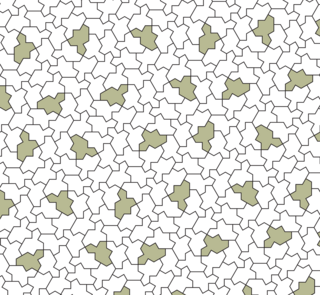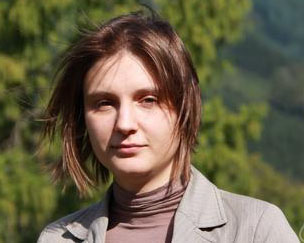Related Research Articles
The Kepler conjecture, named after the 17th-century mathematician and astronomer Johannes Kepler, is a mathematical theorem about sphere packing in three-dimensional Euclidean space. It states that no arrangement of equally sized spheres filling space has a greater average density than that of the cubic close packing and hexagonal close packing arrangements. The density of these arrangements is around 74.05%.

In geometry, a sphere packing is an arrangement of non-overlapping spheres within a containing space. The spheres considered are usually all of identical size, and the space is usually three-dimensional Euclidean space. However, sphere packing problems can be generalised to consider unequal spheres, spaces of other dimensions or to non-Euclidean spaces such as hyperbolic space.
In computer science, the longest increasing subsequence problem aims to find a subsequence of a given sequence in which the subsequence's elements are sorted in an ascending order and in which the subsequence is as long as possible. This subsequence is not necessarily contiguous or unique. The longest increasing subsequences are studied in the context of various disciplines related to mathematics, including algorithmics, random matrix theory, representation theory, and physics. The longest increasing subsequence problem is solvable in time where denotes the length of the input sequence.

Michel Pierre Talagrand is a French mathematician. Docteur ès sciences since 1977, he has been, since 1985, Directeur de Recherches at CNRS and a member of the Functional Analysis Team of the Institut de Mathématique of Paris. Talagrand was elected as correspondent of the Académie des sciences of Paris in March 1997, and then as a full member in November 2004, in the Mathematics section.
In mathematics, the moving sofa problem or sofa problem is a two-dimensional idealisation of real-life furniture-moving problems and asks for the rigid two-dimensional shape of largest area that can be maneuvered through an L-shaped planar region with legs of unit width. The area thus obtained is referred to as the sofa constant. The exact value of the sofa constant is an open problem. The currently leading solution, by Joseph L. Gerver, has a value of approximately 2.2195 and is thought to be close to the optimal, based upon subsequent study and theoretical bounds.

Greg Kuperberg is a Polish-born American mathematician known for his contributions to geometric topology, quantum algebra, and combinatorics. Kuperberg is a professor of mathematics at the University of California, Davis.
Lawrence David Guth is a professor of mathematics at the Massachusetts Institute of Technology.

Joel Hass is an American mathematician and a professor of mathematics and at the University of California, Davis. His work focuses on geometric and topological problems in dimension 3.
In combinatorial mathematics, probability, and computer science, in the longest alternating subsequence problem, one wants to find a subsequence of a given sequence in which the elements are in alternating order, and in which the sequence is as long as possible.

YitangZhang is a Chinese-American mathematician primarily working on number theory and a professor of mathematics at the University of California, Santa Barbara since 2015.

James Alexander Maynard is an English mathematician working in analytic number theory and in particular the theory of prime numbers. In 2017, he was appointed Research Professor at Oxford. Maynard is a fellow of St John's College, Oxford. He was awarded the Fields Medal in 2022 and the New Horizons in Mathematics Prize in 2023.

In plane geometry, the einstein problem asks about the existence of a single prototile that by itself forms an aperiodic set of prototiles; that is, a shape that can tessellate space but only in a nonperiodic way. Such a shape is called an einstein, a word play on ein Stein, German for "one stone".

Svetlana Yakovlevna Jitomirskaya is a Soviet-born American mathematician working on dynamical systems and mathematical physics. She is a distinguished professor of mathematics at Georgia Tech and UC Irvine. She is best known for solving the ten martini problem along with mathematician Artur Avila.

Maryna Sergiivna Viazovska is a Ukrainian mathematician known for her work in sphere packing. She is a full professor and Chair of Number Theory at the Institute of Mathematics of the École Polytechnique Fédérale de Lausanne in Switzerland. She was awarded the Fields Medal in 2022.
Thomas Royen is a retired German professor of statistics who has been affiliated with the University of Applied Sciences Bingen. Royen came to prominence in the spring of 2017 for a relatively simple proof for the Gaussian Correlation Inequality (GCI), a conjecture that originated in the 1950s, which he had published three years earlier without much recognition. A proof of this conjecture, which lies at the intersection of geometry, probability theory and statistics, had eluded top experts for decades.

The Gaussian correlation inequality (GCI), formerly known as the Gaussian correlation conjecture (GCC), is a mathematical theorem in the fields of mathematical statistics and convex geometry.
Kurt Johansson is a Swedish mathematician, specializing in probability theory.
The Baik–Deift–Johansson theorem is a result from probabilistic combinatorics. It deals with the subsequences of a randomly uniformly drawn permutation from the set . The theorem makes a statement about the distribution of the length of the longest increasing subsequence in the limit. The theorem was influential in probability theory since it connected the KPZ-universality with the theory of random matrices.
References
- ↑ UC Davis Mathematics, Dan Romik.
- ↑ Dan Romik at the Mathematics Genealogy Project.
- ↑ ZbMath Open, Dan Romik.
- ↑ Dan Romik, Publications.
- ↑ UC Davis News, LAURELS: Mathematician Romik receives early-career grant
- ↑ "Simons Fellows in Mathematics". Simons Foundation. June 20, 2012.
- ↑ "All time invited speakers · FPSAC / SFCA". fpsac.org.
- ↑ "Invited Speakers · AofA2017". aofa2017.cs.princeton.edu.
- ↑ "Fpsac 2021 · FPSAC / SFCA". fpsac.org.
- ↑ Romik, Dan (2023). "On Viazovska's modular form inequalities". Proceedings of the National Academy of Sciences of the United States of America. 120 (43): e2304891120. arXiv: 2303.13427 . doi: 10.1073/pnas.2304891120 . PMID 37851677. S2CID 257687204.
- ↑ Numberphile, The Moving Sofa Problem.
- ↑ Popular Mechanics, Why Mathematicians Cannot Solve the Problem of Moving Your Sofa
- ↑ Visual Insight, American Mathematical Society Blogs, Romik's Ambidextrous Sofa
- ↑ Phys.org, New twist on sofa problem that stumped mathematicians and furniture movers
- ↑ The Daily Express, Moving a sofa into a house is so tricky - it's stumped mathematicians for years
- ↑ 3DPrint.com, UC Davis Mathematician Uses 3D Printing to Deliver New Insight into Moving Sofa Problem
- ↑ 3 Quarks Daily, Moving Sofas in the Apocalypse
- ↑ De Econometrist, The Moving Sofa Problem
- ↑ OpenMind, Once Upon a Time, a Sofa in a Hallway…
- ↑ "Dan Romik's home page - Software" . Retrieved October 23, 2023.
- ↑ MadHat - About.
- ↑ "The Surprising Mathematics of Longest Increasing Subsequences - Book Review". ZbMath Open. Retrieved September 23, 2023.
- ↑ "The Surprising Mathematics of Longest Increasing Subsequences - Book Review". MAA Reviews. Retrieved September 23, 2023.
- ↑ "The Surprising Mathematics of Longest Increasing Subsequences - Book Review". MathSciNet Mathematical Reviews. MR 3468738 . Retrieved September 23, 2023.